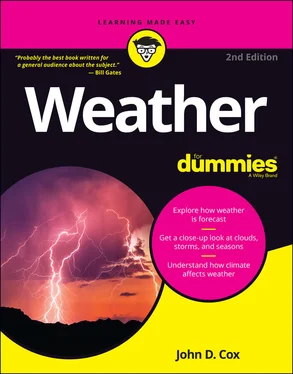This is a uniquely modern experience. Nobody before us has ever witnessed a more helpful or accurate prediction of the future behavior of the atmosphere. This short, precise presentation is an honest-to-goodness scientific marvel, the result of many years of demanding research and incredible expense.
They make it look slick and easy on TV, of course — the smoothly moving images, the colorful animations driven by extremely high-powered computer models — but before that forecast got to the television studio, a lot of hard-knuckle science went into creating it. And hard-knuckle life. In 19th-century England, the first man to issue a weather forecast, Vice-Admiral Robert FitzRoy, an English officer in the Royal Navy, was pleading the case for so many sailors lost at sea. He didn’t succeed, but he died trying, and he left behind the popular idea that weather services are a government obligation.
The scientific knowledge that made modern forecasting possible did not come easily over the years. Earth does not very willingly give up her big secrets. During World War I, the young Englishman Louis Fry Richardson, a brilliant mathematician, described his impossible dream of a “forecast factory” — a multi-layered, gridded theoretical “atmosphere” tended by hundreds of individuals sharing data with others attending adjacent blocks of air. During World War II, a stable of brilliant scientists built the first electronic computer that was actually capable of such an ingenious, enormously complex undertaking. So, in the 1950s, began the new computer-driven era of “numerical weather prediction” and it changed everything.
The advent of weather satellites in the 1960s made visually obvious to everyone what research meteorologists had been grappling with all along: weather’s natural enormity — the truly planetary scale of the problems they were trying to solve. ( Chapter 16delves into the forecasting work of satellites and other tools in the weather forecaster’s toolbox.)
So why is there weather? What basic forms does it take? Chapter 3is where you find the answers to these questions. Sometimes it helps to think of the atmosphere as a blanket that has been thrown over the planet. The blanket’s surface is not entirely smooth. There are ridges and folds and bumps and dips here and there. This is where storms are, in these imperfections. Chapter 3explains why there are storms and Chapter 4describes precipitation in all its shapes and sizes. Here you get the idea of different air masses meeting along fronts like opposing armies.
Weather is a very popular subject when there are big storms brewing or when things like summer temperatures are getting to be extreme. These are the weather celebrities that get all the media attention: tornadoes, heatwaves, ice storms. In Part 2, you find a chapter devoted to hurricanes, perhaps the biggest weather celebrity of all.
But behind every storm and every heatwave and every cold snap is a cast of characters that are responsible for the whole production. They make the winds blow. They form the clouds. Chapter 5answers the question, “why all this wind?” and explains how air pressure is the cause. In Chapter 6, you pick up a little Latin: cirrus, stratus, cumulus, nimbus. Can you tell one type of cloud from another? This chapter also gives you the lowdown on all forms of clouds and how you can tell if there’s rain on the way or something a bit more sinister brewing. And there are two pages of color photographs in this book devoted to the basic cloud types that are spelled out in this part.
If you live in the same part of the world very long, eventually you get fairly set in your ways about what to expect of the different seasons through the year. Winter, spring, summer, and fall have certain personalities, certain kinds of storms, certain ranges of temperature. And fair weather has a different feel to it from one season to the next.
Part 3is organized around this general idea about different seasons coming in different varieties of weather. It begins with the big storms of winter, focuses on the tornadoes of spring and the thunderstorms and temperature extremes of summer, and it takes a good look at hurricanes that reach their seasonal peak in autumn. It is helpful as far as it goes, this way of organizing our thoughts, but it’s worth remembering that every region of the globe has its own variety of seasons.
 The seasons don’t really “arrive” at the same time and in the same place around the world, and they don’t really act quite the same everywhere. Winter in the Northern Hemisphere is summertime in the Southern Hemisphere. The closer you live to the Equator, the less pronounced are the seasonal differences, although still there are wet seasons and dry seasons. Likewise, the polar regions, above 60 degrees north or south latitude, get only cool, glancing visits from the Sun all year long. Only the middle latitudes, north and south, get the full effects of the seasons.
The seasons don’t really “arrive” at the same time and in the same place around the world, and they don’t really act quite the same everywhere. Winter in the Northern Hemisphere is summertime in the Southern Hemisphere. The closer you live to the Equator, the less pronounced are the seasonal differences, although still there are wet seasons and dry seasons. Likewise, the polar regions, above 60 degrees north or south latitude, get only cool, glancing visits from the Sun all year long. Only the middle latitudes, north and south, get the full effects of the seasons.
But it’s not just latitude, you know, your distance from the Equator, that shapes the seasons. Early New England settlers learned that the hard way, having left England expecting to land in a climate akin to the south of France. As it happens, Sacramento, California, has the same latitude as Washington, D.C., on the other side of the continent, yet all their seasons are very different from one another. Chapter 10tells you why.
Something else is going on with the seasons. Changes in the composition of our atmosphere are changing these annual climate patterns. Winters are getting shorter, summers are getting longer, and the arrival times of all seasons are less reliable than they used to be. So look at Part 3as a set of flexible guidelines that are subject to change, as a way of organizing some thinking about the weather events in your life.
If you want to know the signs of a changing climate, look through Chapter 13and see what it is doing to our weather. This is where climate hits the road, and where climate science has traveled far since the days when the first edition of Weather For Dummies hit the press. Generalized expectations have evolved into specific cases in point.
 Now we know what the weather of a changing climate will be like. Just look at what prolonged drought and rising heat have done to the forests and wilderness of Australia and western North America. Thousands of square miles of natural habitat have been devoured by raging fires and millions of wild creatures have been lost. Hurricanes and other tropical cyclones are becoming bigger and more dangerous, moving more slowly over land and causing more flooding. Wets are getting wetter; hots are getting hotter. The Arctic is rapidly losing its ice cover, breaking down the polar wind pattern that usually keeps frigid air from wandering south into the middle latitudes. More ominously, Greenland is rapidly losing its ice sheet, a circumstance that could hasten sea-level rise and disrupt the Atlantic Ocean’s conveyor of warm ocean currents to Northern Europe. Scientists expect other abrupt surprises along the way.
Now we know what the weather of a changing climate will be like. Just look at what prolonged drought and rising heat have done to the forests and wilderness of Australia and western North America. Thousands of square miles of natural habitat have been devoured by raging fires and millions of wild creatures have been lost. Hurricanes and other tropical cyclones are becoming bigger and more dangerous, moving more slowly over land and causing more flooding. Wets are getting wetter; hots are getting hotter. The Arctic is rapidly losing its ice cover, breaking down the polar wind pattern that usually keeps frigid air from wandering south into the middle latitudes. More ominously, Greenland is rapidly losing its ice sheet, a circumstance that could hasten sea-level rise and disrupt the Atlantic Ocean’s conveyor of warm ocean currents to Northern Europe. Scientists expect other abrupt surprises along the way.
There’s a lot going on in the sky. Unfortunately for people who live in many major cities, the sky over their heads is clogged with extra gases and other material that has been dumped into it. Weather doesn’t put that stuff up there, of course, but it sure has a lot to do with how bad it gets. Chapter 14takes a deep dive into air pollution and looks at all that stuff in the sky that didn’t used to be there and doesn’t belong there.
Читать дальше

 The seasons don’t really “arrive” at the same time and in the same place around the world, and they don’t really act quite the same everywhere. Winter in the Northern Hemisphere is summertime in the Southern Hemisphere. The closer you live to the Equator, the less pronounced are the seasonal differences, although still there are wet seasons and dry seasons. Likewise, the polar regions, above 60 degrees north or south latitude, get only cool, glancing visits from the Sun all year long. Only the middle latitudes, north and south, get the full effects of the seasons.
The seasons don’t really “arrive” at the same time and in the same place around the world, and they don’t really act quite the same everywhere. Winter in the Northern Hemisphere is summertime in the Southern Hemisphere. The closer you live to the Equator, the less pronounced are the seasonal differences, although still there are wet seasons and dry seasons. Likewise, the polar regions, above 60 degrees north or south latitude, get only cool, glancing visits from the Sun all year long. Only the middle latitudes, north and south, get the full effects of the seasons.










